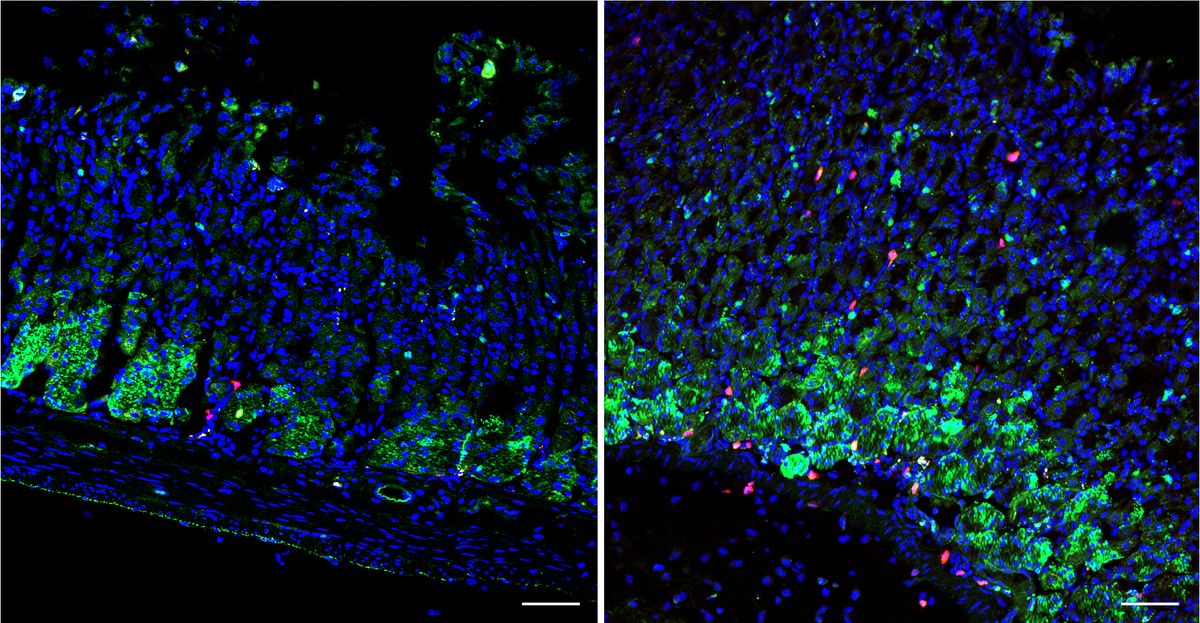Most dietary fibers are broken down by the microbiome because they are too complicated for digestion by the stomach and intestines alone. However, in a paper published in Science, a team at Washington University reported that the stomach uses an immune-mediated circuit to digest chitin, a ubiquitous structural fiber found in fungi, shrimp, and insects, and that this circuit also influences metabolic homeostasis.1 These findings could help scientists understand the relationship between digestive processes and metabolic activities.
Chitin is often found in airway allergens like dust mites and spores. It activates type two immune responses, the body’s defenses against allergens or parasites, which include type 2 innate lymphoid cells (ILC2), a group of immune cells that produce cytokines to drive allergic or parasitic responses.2 ILC2 also induce the production of chitinase, an enzyme that breaks down chitin in airways.3 However, this may not be the full story of chitin and ILC2.
“These types of immune responses are involved in many more functions in humans and mammals than just torturing us with allergies,” said Steven Van Dyken, an immunologist at Washington University and coauthor of the study.
See Also “A Snapshot of How Obesity Transforms Fat“
Since chitin ends up in the stomachs of animals that consume large quantities of insects or fungi, but not much is known about ILC2’s role in this organ, Van Dyken and his team explored gastric ILC2 responses to chitin in mice. To investigate these functions, Van Dyken and his team fed mice either standard food with cellulose, a similar and more common dietary fiber, or food with up to 20 percent chitin.

Chitin triggers an increase in the number of ILC2 (red) and the expression of AMCase (green) in the stomachs of mice.
Do-Hyun Kim and Steven Van Dyken
Chitin-eating mice had increased stomach thickening and higher numbers of chemosensory epithelial cells, called tuft cells, in their stomachs compared to cellulose-eating mice, suggesting that digesting chitin remodeled the existing tissue. Chitin also induced distention of the stomach, which caused tuft cells to produce ILC2-activating cytokines. This coincided with increased numbers of ILC2 in the stomach. Because ILC2 maintain metabolic homeostasis in adipose tissue, the team investigated ILC2 responses in this tissue and found that chitin increased the number of activated ILC2 in adipose tissue.4
ILC2 cytokines induce the production of acid mammalian chitinase (AMCase) to degrade chitin in the lung, so the team explored whether a similar process happened in the stomach. By comparing ILC2-deficient mice with normal mice, the team observed reduced expression of Chia1, the gene encoding AMCase, in the stomach chief cells of ILC2-deficient mice.
To explore the effect of AMCase on dietary responses to chitin, the team deleted Chia1 to generate mice lacking AMCase. After two weeks on the chitin-enriched diet, normal mice exhibited decreased stomach distention, and after four weeks, they showed lower numbers of activated ILC2 in the stomach, small intestine, and adipose tissue, whereas these parameters remained high in AMCase-deficient mice. This suggested that ILC2-mediated AMCase expression is necessary for the adaptation to dietary chitin, and that disrupting this circuit leads to altered ILC2 activity in gastrointestinal and adipose tissues.
See Also “‘Gut Feeling’ Takes on New Meaning“
Finally, the team used a high-fat diet model with either cellulose or chitin as the fiber component to explore the potential metabolic influence of dietary chitin and ILC2 activation. As they previously saw, AMCase-deficient animals maintained greater numbers of ILC2 in their adipose tissues and gastrointestinal tracts. Surprisingly, AMCase-deficient mice with chitin in their diets gained weight at a slower rate than normal mice that also ate chitin. These animals also expended more energy and had a higher respiration rate than animals with functional AMCase. However, chitin-eating mice had better glucose and insulin tolerance than animals eating a high-fat diet with cellulose. This finding suggested that the adaptation to chitin through AMCase and ILC2 activation plays an important role in metabolic homeostasis.
“What’s really exciting about this paper is that it links all of this to a new stimulus and a new way to turn it on, which is digestion of chitin and distention of the stomach,” said Jakob von Moltke, an immunologist at the University of Washington who was not involved in the study. “Additionally, it places this sort of circuit in the stomach where it hasn’t really been described before.”
References
- Kim D-H, et al. A type 2 immune circuit in the stomach controls mammalian adaptation to dietary chitin. Science. 2023;381(6662):1092-1098.
- Price AE, et al. Systemically dispersed innate IL-13-expressing cells in type 2 immunity. Proc Natl Acad Sci. 2010;107(25):11489-11494
- Weber-Chrysochoou C, et al. Chitinase-induced airwary hyperreactivity and inflammation in a mouse model of nonallergic asthma. Int Arch Allergy Immunol. 2021;182(7):563-570.
- Molofsky AB, et al. Innate lymphoid type 2 cells sustain visceral adipose tissue eosinophils and alternatively activated macrophages. J Exp Med. 2013;210(3):535-549
